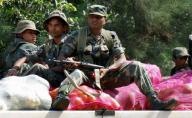 Sri Lanka said this week it would not use heavy weapons while it moves into the last pocket held by the Tamil Tiger guerrillas, but that has not prevented it from squeezing the rebels into an ever smaller area.
Sri Lanka said this week it would not use heavy weapons while it moves into the last pocket held by the Tamil Tiger guerrillas, but that has not prevented it from squeezing the rebels into an ever smaller area.
The military says the Tigers are now down to just 5 square kilometres, and the governnment is thus far resisting international calls for a ceasefire to allow tens of thousands of civilians trapped in the battle zone to leave.
Here are questions and answers about what’s next for the Tigers:
ARE THE TIGERS DEFEATED AS A CONVENTIONAL FORCE?
Any day from now, yes. It is difficult to say how many Liberation Tigers of Tamil Eelam (LTTE) fighters remain — estimates range as low as 500 and as high as 2,000 — but the Sri Lankan army and navy have them boxed in, outgunned and outmanned. Their call for a truce this week was met with laughter by Sri Lanka’s defence secretary. At the height of their power three years ago, the LTTE controlled 15,000 square km. Now they hold a tiny patch of coastline. Over the last few weeks, intelligence has confirmed the deaths of several top-tier commanders and others have surrendered, the military says. Although both sides have repeatedly inflated enemy casualty figures for propaganda value, few doubt the Tigers are getting thrashed. It is worth noting that throughout the campaign the army commander, Lt-Gen. Sarath Fonseka, has made a high enemy kill rate a priority over capturing territory, figuring the former begets the latter, and the military continued to report inflicting significant casualties this week despite its proclaimed switch to only light weapons.
DOES THAT MEAN THE LTTE IS FINISHED?
No. The Tigers still have widespread support from the global Tamil diaspora, and within the large Tamil populace in India, and have established an international smuggling and support network that has helped them stay alive. They have vowed no surrender in their fight for a separate state for Sri Lanka’s Tamil minority. Although terrorism financing laws and joint efforts to shut down LTTE fronts have succeeded in cutting off much support, not all links are severed. The LTTE is on U.S., EU, Indian and Canadian terrorist lists. Interestingly, the man in charge of LTTE weapons procurement for years, S. Pathmanathan, has now been made the Tigers’ international diplomatic point man, a fact the LTTE has confirmed to Reuters. Diplomats, including those close to the LTTE, have questioned the move since he is wanted by Interpol.
WHAT ABOUT LEADER VELLUPILLAI PRABHAKARAN?
The military believes he is hiding inside the last Tiger-held pocket. The LTTE has repeatedly said, including this week, that he is with the people, and the military publicly says he is in the war zone. But that means very little in terms of the actual whereabouts of a man who has excelled at giving authorities the slip since the early 1970s.
WHAT CAN THE LTTE DO NOW?
Eastern Sri Lanka, captured from the LTTE in 2007, provides a good idea of what can be expected. There, small groups of LTTE still hide in the bush and attack police, soldiers and civilians sporadically. However, the military and the elite Special Task Force police commandos have begun hunting them down. Rumours also abound that some hardcore Tigers will hide in the nearby south Indian state of Tamil Nadu, looking for a chance to regroup.
And of course, the Tigers more than any other group popularised the suicide blast as a weapon of war. In spite of tight security across the country, a few of those are bound to happen again. One sign of the seriousness of that threat — security forces earlier this month seized 250 kg of explosives being smuggled into the capital, Colombo.
(For updates you can share with your friends, follow TNN on Facebook and Twitter )
